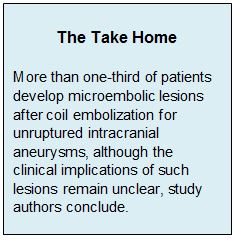Key Points:
- Study looks at predictors of microembolic lesions after endovascular coiling of unruptured intracranial aneurysms
- Atherosclerotic risk factors, multiple aneurysms, stent selection all influence risk

For this retrospective review, investigators led by Deok Hee Lee, MD, from Asan Medical Center (Seoul, South Korea), examined data on 271 consecutive patients (median age 57 years; 75% women) who were treated with endovascular coiling between July 2011 and June 2013. On the day after embolization, patients underwent MR diffusion-weighted imaging (DWI) to identify microembolic lesions.
Overall, microembolic lesions were noted in 37.3% of patients. Of the 101 patients with lesions, only 3 were symptomatic.
Multivariate analysis revealed several independent predictors of the presence of microembolic lesions, including age, diabetes, history of stroke, use of the Enterprise stent (Codman), high-signal (Fazeka Grade 2-3) FLAIR lesions in the white matter, and multiple aneurysms (table 1).
Table 1. Multivariate Predictors of Microembolic Lesions
|
|
Adjusted OR |
OR (95% CI) |
|
Use of Enterprise Stent |
10.72 |
2.90-39.61 |
|
High-Signal White Matter Lesions |
5.48 |
1.93-15.60 |
|
History of Stroke |
3.58 |
1.03-12.40 |
|
Diabetes |
3.21 |
1.54-6.76 |
|
Age, per year |
1.04 |
1.01-1.08 |
However, previously identified risk factors for microembolism, including prolonged procedure duration, aneurysm size, and decreased antiplatelet function, were not predictive.
Benefit to Minimizing Lesions Unclear
“Over 70% of our cohort showed less than 5 [high-intensity] spots, and 97% of our DWI-positive patients were asymptomatic,” write the authors. “It could be assumed that seeking to identify such imaging abnormalities would provide only minor clinical benefits compared with the use of less invasive endovascular treatments.”
On the other hand, “the clinical and long-term consequences of harboring a postembolization microembolism remain controversial,” they write. “In a previous study, a higher number of microemboli detected as DWI-positive spots may have been a surrogate marker for symptomatic ischemic complication.
“Microembolic silent brain ischemia is also a contributor to cognitive decline and dementia,” they continue. “In addition, these microembolic lesions after interventional procedures negatively impact cognitive functions. Because there is no unanimous opinion regarding the risks associated with harboring such lesions, it might be beneficial to reduce their numbers as much as possible.”
Source:
Park JC, Lee DH, Kim JK, et al. Microembolism after endovascular coiling of unruptured cerebral aneurysms: incidence and risk factors. J Neurosurg. 2015;Epub ahead of print.
Disclosures:
- Dr. Lee reports no relevant conflicts of interest.

